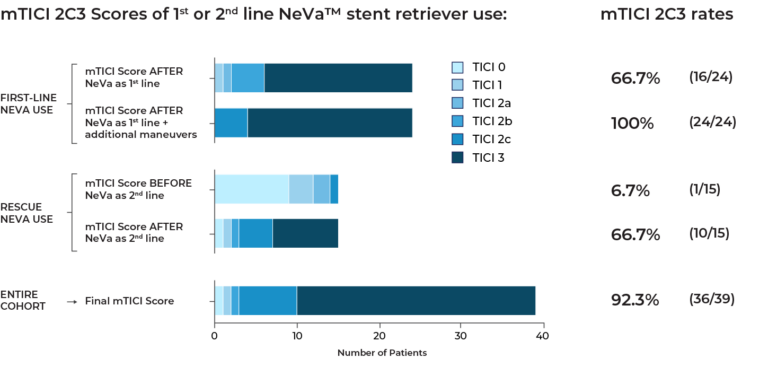Paper:
Evaluation of effectiveness and safety of the multizone NeVa™ stent retriever for mechanical thrombectomy in ischemic stroke.Authors:
Max Masthoff, Hermann Krähling, Burak Han Akkurt, Mohamed Elsharkawy, Michael Köhler, Mostafa Ergawy, Christian Thomas, Wolfram Schwindt, Jens Minnerup & Paul StrackeJournal:
Interventional NeuroradiologyPurpose:
This study aimed to evaluate the effectiveness and safety of the NeVa stent retriever as first- and second-line device for mechanical thrombectomy in acute ischemic stroke.Methods:
In this retrospective single-center study, all consecutive patients that underwent mechanical thrombectomy with NeVa stent retriever as first- or second-line device due to intracranial vessel occlusion with acute ischemic stroke between March and November 2022 were included.Results:
Thirty-nine patients (m=18, f=21) with a mean age of 69.9 ± 13.3 years were treated with the NeVa stent retriever. NeVa stent retriever was used as first-line device in 24 (61.5%) of patients and in 15 (38.5%) as second-line device. First-pass rate (≥mTICI 2c) of NeVa stent retriever was both 66.7% when used as first- or second-line device. Final recanalization rate including rescue strategies was 92.3% for ≥mTICI2c and 94.9% for ≥mTICI2b. No device-related minor or major adverse events were observed. A hemorrhage was detected in 33.3% of patients at 24h post-thrombectomy dual-energy CT, of which none was classified as symptomatic intracerebral hemorrhage. NIHSS and mRS improved significantly at discharge compared to admission (p<0.05).
Conclusion:
The NeVa stent retriever has a high effectivity and good safety profile as first- and second-line device for mechanical thrombectomy in acute ischemic stroke.